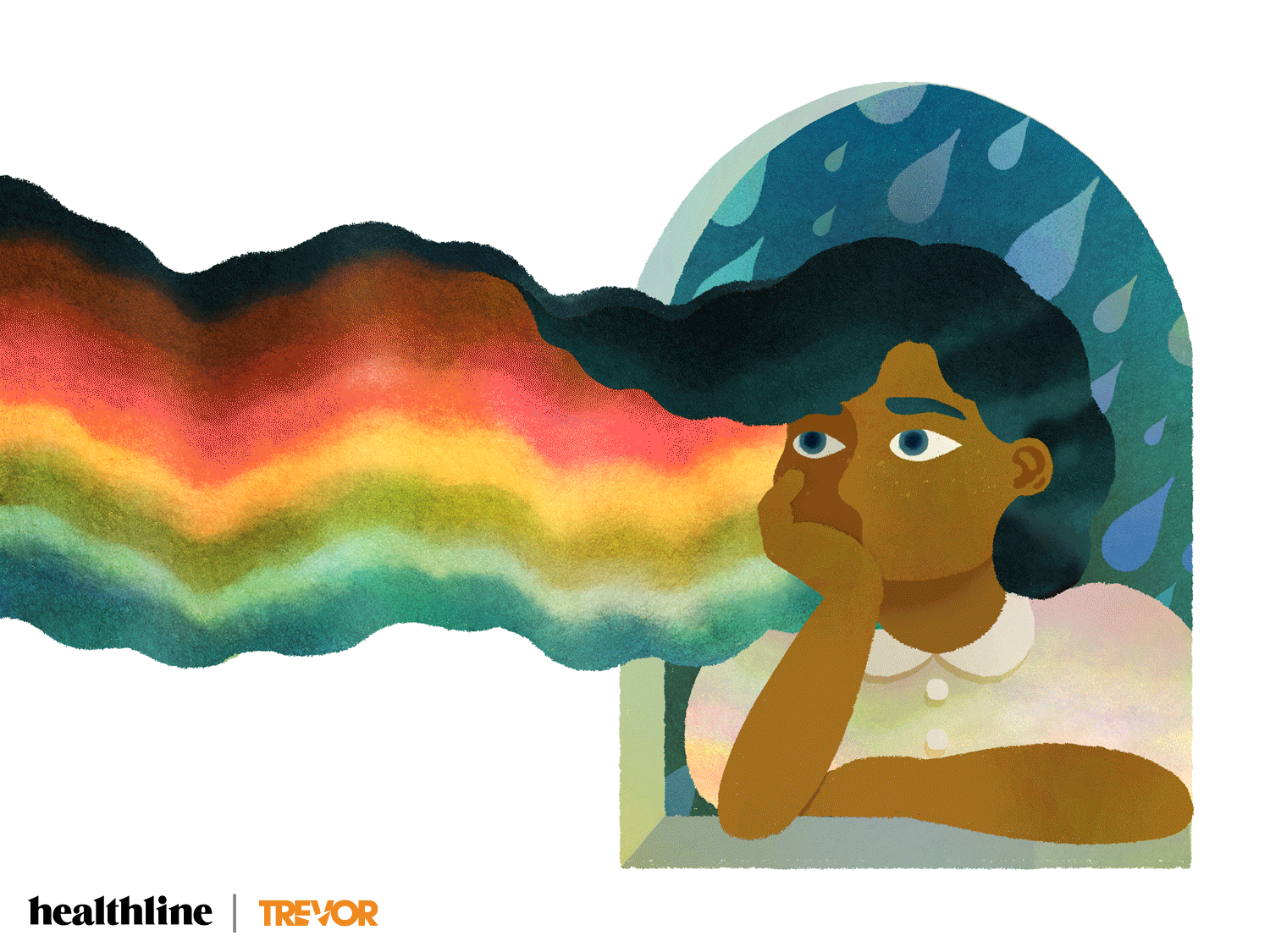
When I was 17 years old, I really did not want to be gay. I did not want to have a crush on my basketball teammate like I did. I wore heels and skirts out to parties, hoping they would disguise my tomboyish mannerisms. I truly believed I would be alone forever.
Fast-forward to a few days ago when I celebrated my 37th birthday with a group of friends who are diverse in race, profession, and sexual orientation, and who were invited by my fiancé, the most brilliant and beautiful woman I know. Moments like this one remind me that it does, and it did, get better.
For context, I am a Black, queer, masculine-presenting cis female who works as a psychiatrist. I am living my “dream,” technically. Yet, I continue to struggle with severe anxiety and depression despite consistent treatment with medication and therapy for over a decade. In fact, one of the reasons I decided to become a psychiatrist in the first place was to better understand my anxiety, which first manifested in high school in the form of panic attacks.
My reflections come on the heels of the results from The Trevor Project’s third annual National Survey on LGBTQ Youth Mental Health. For those of you who may not know much about The Trevor Project, it’s a nonprofit focused on suicide prevention for lesbian, gay, bisexual, transgender, queer, and questioning youth through 24/7 crisis services platforms.
As a psychiatrist, the results of this year’s report are unfortunately not surprising, but still deeply disturbing. Out of the nearly 35,000 LGBTQ youth who were surveyed, 42 percent of respondents between the ages of 13 and 24 had seriously considered attempting suicide within the past 12 months, with more than half identifying as trans or nonbinary youth.
Looking closer at the data, values were higher for those ages 13 to 17, the age range we label “adolescence.” When most of us think about adolescence, we probably think about typical teenage angst centered around getting good grades, managing bad acne, or whether your crush likes you back.
For mental health professionals, adolescence represents a period where individuals try to solidify who they are, what they believe in, and what they want. What The Trevor Project report shows is that LGBTQ adolescents are not only grappling with typical teenage concerns, but also relentless bullying at school and, for some, where they will find their next meal.
For example, an HRC Foundation analysis of the CDC’s 2019 Youth Risk Behavior Survey shows that 29 percent of transgender youth have been threatened with a weapon on school property. Data from The Trevor Project suggests that 30 percent of LGBTQ youth experienced food insecurity in the past month, and that 1 in 4 will experience housing instability at some point in their life.
These numbers paint a much different picture of adolescence for LGBTQ youth and provide for additional worries like whether they want to stay alive.
This is not to say that “typical” adolescent concerns are not distressing as well. However, from my own experience and that of patients, I know how hard it can be to manage both traditional psychosocial dilemmas and intersectional identities.
While my panic attacks in high school may have been triggered by exams, college applications, and a perceived lack of time due to extracurricular activities, my chronic anxiety was kept alive by worrying how I fit in among my peers as a Black closeted lesbian. I spent so much of my emotional energy on edge, worried that my actions would betray my secret to those around me.
At school, classmates questioned my acceptance to Stanford, citing my race rather than my intelligence as the major admission factor. At home, in West Palm Beach, Florida, where religious values were at the forefront, liking girls put my soul in jeopardy of going to hell.
The Trevor Project results suggest concerns like mine are common for LGBTQ youth in general. For example, half of respondents reported discrimination based on their race/ethnicity in the past year, and only 1 out of 3 found their homes to be LGBTQ-affirming.
I see similar themes in my work with patients with depression in their 20s or 30s related to mental health struggles that began in their youth. They recall stories about not fitting into their racial communities or feeling undesirable as genderqueer teens.
Their experiences correlate with The Trevor Project findings that in the two weeks preceding the survey, 72 percent of LGBTQ youth reported symptoms of generalized anxiety and 62 percent reported symptoms of major depressive disorder.
This brings me to the results that are the most distressing for me: Nearly half of LGBTQ youth wanted counseling from a mental health professional in the past year but did not receive it. The harrowing truth is, help is hard to find, as there are on average only 9.75 child psychiatrists per 100,000 children in the United States with 70 percent of counties having no child psychiatrists.
I think of how many young people continue to live their lives alone in their thoughts, unable to share with family or friends. This is especially true during the COVID-19 pandemic, when more than 80 percent reported that their living situation has been made more stressful, and 70 percent stated that their mental health was “poor” most of the time.
It’s not difficult to imagine how symptoms like depression and anxiety transform into suicidal thinking over time without help.
Truthfully, I do not have faith that the workforce will grow to meet the demand in the foreseeable future. A few times a month, I receive an email from a frantic parent, a former classmate, or a colleague asking if I treat children or if I could connect them to a child psychiatrist. (I am trained as an adult psychiatrist and see patients over age 18.)
Every time I read one of these emails, I feel a wave of sadness knowing the uphill battle these kids and their families will face in looking for a provider that is probably not taking new patients, is too costly and out of network, or does not understand their plight as People of Color.
I wonder whether their kids will contribute to the continued trend in data showing increased rates of suicidal thinking among youth of color, a group that had historically seen relatively low rates compared to white youth up until the 2000s.
What will adulthood be like for these respondents if they do not receive help? Or, more importantly, what could help look like?
Despite the obstacles, I believe help can come in many forms.
Firstly, we will need more mental health providers if we want to reduce the risk of youth suicide and the preceding symptoms that represent a cry for help, like depression or anxiety. In the meantime, we need to ensure that pediatric providers, teenagers, and guidance counselors receive training to identify the special needs of LGBTQ youth with depression, anxiety, or other mental health symptoms and intervene before suicide becomes an option.
Secondly, we need to continue to elect politicians that will protect the rights of LGBTQ individuals, like Sarah McBride, the first openly transgender state senator, and other LGBTQ policymakers with intersectional identities.
And we need to get involved on the ground level, too. Right now, there is a record-breaking amount of anti-trans legislation being passed or proposed across the country. Parents, teachers, doctors, and friends of LGBTQ individuals need to hold state politicians who create laws designed to hurt young people accountable by voting them out when it is time, especially since young people under 18 cannot vote themselves.
Thirdly, let’s be courageous in sharing our stories about our own mental health struggles to reduce the stigma of asking for help. The more adults who normalize discussing emotional health and seeking assistance, the more likely young people will feel comfortable speaking up and asking for help.
I applaud the transparency of LGBTQ celebrities like Demi Lovato and Ruby Rose who discuss their personal experiences seeking help for mental health issues publicly, and I encourage more of us to do the same.
As difficult as it is to confront the reality painted by the more concerning findings in the new Trevor Project report, it does not tell the full story of LGBTQ youth.
The report ends by naming hundreds of ways respondents find joy — from watching anime to seeing rainbow flags in public to spending time with chosen family. The comments about joy remind me of the numerous LGBTQ patients I have seen over the years and their resilience in being able to express themselves and find support in unlikely places.
Similarly, I am also reminded of my own high school friends who were excited for me to come out of the closet, already suspecting that I was queer. I hear a song by rapper Lil Nas X on the radio, see a post by trans activist Ashlee Marie Preston on my Instagram feed, or laugh at the antics of Ncuti Gatwa’s Nigerian queer character on the TV show “Sex Education” and feel encouraged by the openness and bravery of these folks who serve as role models for so many.
I remember my own mentors who were proudly out in their roles as medical school deans and who encouraged me to be open about my sexuality, as well, when applying for medical school. And I think of my future genderqueer patients who will be excited to start therapy for the first time because they’ll have found a psychiatrist who is “like them.”

